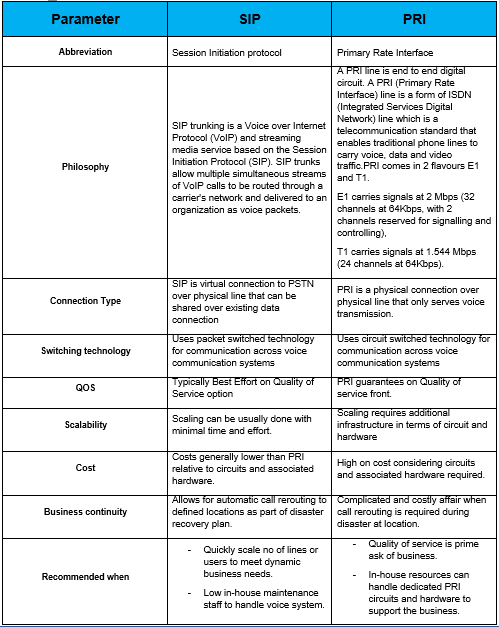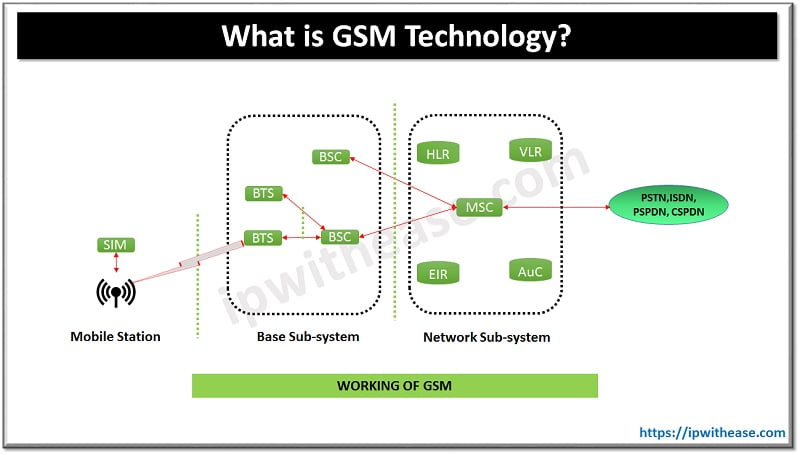What is SIP?
Session Initiation Protocol (SIP) is a virtual connection to the public switched telephone network and is used to signal and control communication sessions like VoIP calls. The capacity of a SIP trunk is equal to the capacity of bandwidth available between the customer and carrier.
What is PRI?
Primary Rate Interface (PRI) is a telecommunications interface standard used on an Integrated Services Digital Network (ISDN) for carrying multiple voices and data transmissions between the network and a user. PRI is a high-capacity service carried as T1 or E1 trunk lines between telco central offices and your location. PRI comes in 2 flavours T1 and E1. A T1 line carries voice and data via 24 digital channels while E1 carries 32 Channels. It delivers multiple lines of voice and data into a business’s existing PBX via one physical line.
SIP Trunking & PRI –
SIP trunking and PRI are two different ways of connecting your business to the PSTN (Public Switched Telephone Network).
Typically PRI and SIP Trunking require a piece of equipment in your office called a PBX (Private Branch Exchange). Most PBX can support both PRI trunk and SIP Trunking connections, either directly or with support of additional component.
SIP vs PRI –
Below table details on the difference between both the Voice communication technology types & SIP trunk vs PRI trunk–
| PARAMETER | SIP | PRI |
|---|---|---|
| Abbreviation for | Session Initiation protocol | Primary Rate Interface |
| Philosophy | SIP trunking is a Voice over Internet Protocol (VoIP) and streaming media service based on the Session Initiation Protocol (SIP). SIP trunks allow multiple simultaneous streams of VoIP calls to be routed through a carrier's network and delivered to an organization as voice packets. | A PRI line is end to end digital circuit. A PRI (Primary Rate Interface) line is a form of ISDN (Integrated Services Digital Network) line which is a telecommunication standard that enables traditional phone lines to carry voice, data and video traffic. PRI comes in 2 flavours E1 and T1. E1 carries signals at 2 Mbps (32 channels at 64Kbps, with 2 channels reserved for signalling and controlling), T1 carries signals at 1.544 Mbps (24 channels at 64Kbps). A PRI line is end to end digital circuit. A PRI (Primary Rate Interface) line is a form of ISDN (Integrated Services Digital Network) line which is a telecommunication standard that enables traditional phone lines to carry voice, data and video traffic. PRI comes in 2 flavours E1 and T1. E1 carries signals at 2 Mbps (32 channels at 64Kbps, with 2 channels reserved for signalling and controlling), T1 carries signals at 1.544 Mbps (24 channels at 64Kbps). |
| Connection Type | SIP is virtual connection to PSTN over physical line that can be shared over existing data connection | PRI is a physical connection over physical line that only serves voice transmission. |
| Switching technology | Uses packet switched technology for communication across voice communication systems | Uses circuit switched technology for communication across voice communication systems |
| QOS | Typically Best Effort on Quality of Service option | PRI guarantees on Quality of service front. |
| Scalability | Scaling can be usually done with minimal time and effort | Scaling requires additional infrastructure in terms of circuit and hardware |
| Cost | Costs generally lower than PRI relative to circuits and associated hardware. | High on cost considering circuits and associated hardware required. |
| Business continuity | Allows for automatic call rerouting to defined locations as part of disaster recovery plan. | Complicated and costly affair when call rerouting is required during disaster at location. |
| Recommended when | Quickly scale no of lines or users to meet dynamic business needs. Low in-house maintenance staff to handle voice system. | Quality of service is prime ask of business. In-house resources can handle dedicated PRI circuits and hardware to support the business. |
![]()
Download the difference table here.
Related – SIP vs SCCP
To know more about SIP vs PRI watch this video –
ABOUT THE AUTHOR

You can learn more about her on her linkedin profile – Rashmi Bhardwaj





Special thank to post sir, I get amuch knowledge for everything, thank again sir😃
Thanks Saw for such kind words of appreciation.